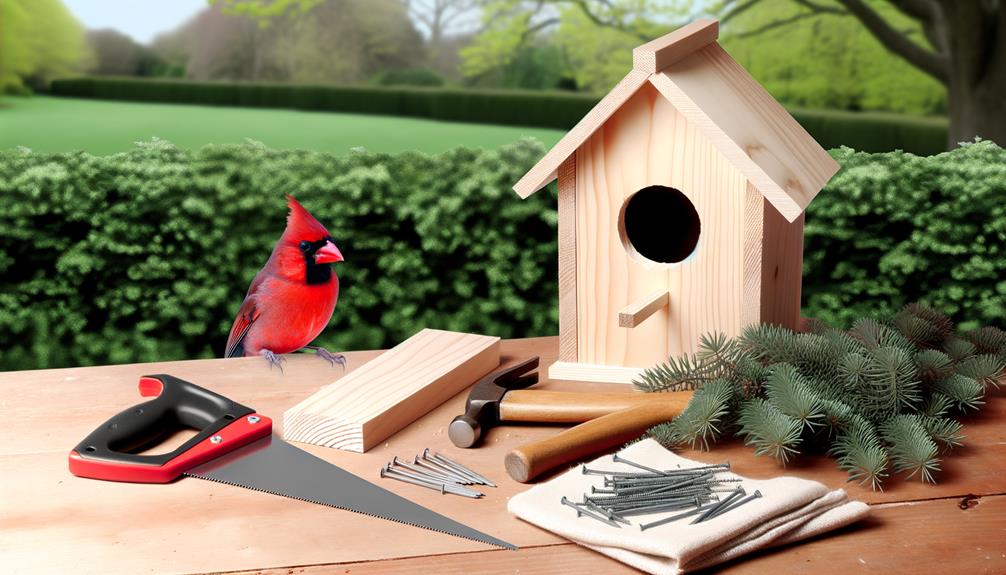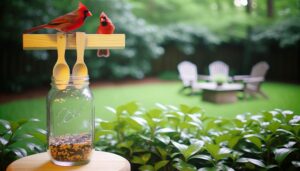5 Simple Steps to Build a Cardinal Bird House
Constructing a cardinal birdhouse requires high-quality, untreated hardwood and essential tools. Begin by carefully measuring and cutting the wood, guaranteeing precision for stability.
Base and structure assemblies need alignment and reinforcement with exterior-grade wood glue and galvanized screws. The entrance hole should be smooth and strategically placed to avoid strong winds.
Incorporate ventilation using fine mesh hardware cloth. Use non-toxic paint to seal the house, offering protection from the elements.
Mount the house 5-7 feet above ground in a predator-safe area near natural cover and food sources. Consistent maintenance secures longevity and a healthy bird habitat.
Learn more for detailed steps.

Key Takeaways
- Use untreated, chemical-free hardwood for durability and safety.
- Cut and assemble wood panels accurately, reinforcing with wood glue and galvanized screws.
- Create a circular entrance hole above the floor and smooth edges.
- Ensure proper ventilation with aeration holes covered with fine mesh hardware cloth.
- Mount birdhouse securely 5-7 feet above ground, away from predators and facing away from winds.
Materials Needed
To construct a cardinal birdhouse, it is crucial to gather specific materials that secure durability, safety, and suitability for the bird's habitat.
The primary material should be untreated wood, such as cedar or pine, which offers resilience against weathering and is non-toxic to birds. An exterior-grade wood glue secures robust joints, while galvanized screws provide added structural integrity, preventing rust over time.
For the roof, weather-resistant shingles or metal sheeting can be employed to shield against precipitation. Additionally, fine mesh hardware cloth may be used to line ventilation openings, securing proper airflow while safeguarding against predators.
Each material should be carefully chosen to balance ecological compatibility and mechanical strength, providing a safe and enduring shelter for cardinals.
Tools Required
Building a cardinal bird house requires a specific selection of tools to guarantee both accuracy and efficiency. Necessary hand tools, such as hammers, screwdrivers, and measuring tapes, are fundamental for foundational tasks.
Furthermore, power tools, like drills and electric saws, are vital for speeding up the construction process and achieving precision in cutting and assembly.
Essential Hand Tools
A complete set of essential hand tools is fundamental for the precise and efficient construction of a cardinal bird house. Accurate measurement begins with a quality tape measure and a combination square, ensuring all components align correctly.
A coping saw allows for intricate cuts, while a handsaw is crucial for larger, straight cuts. Chisels of varying sizes are indispensable for creating notches and fine adjustments. Sandpaper or a sanding block smooths rough edges, enhancing both safety and aesthetic.
Clamps secure pieces during assembly, maintaining stability and precision. Finally, a hammer, paired with appropriately sized nails, facilitates the assembly process. Each tool plays a crucial role in achieving a bird house that is both functional and durable.
Power Tools Needed
Incorporating power tools into the construction process greatly enhances efficiency and precision, enabling the creation of a high-quality cardinal bird house with greater ease.
Essential power tools include a circular saw for accurate wood cutting, a cordless drill for drilling precise holes and driving screws, and a jigsaw for making intricate cuts and curves.
Additionally, a power sander is indispensable for smoothing edges and surfaces, guaranteeing a safe and polished finish. A miter saw can also be advantageous for making precise angled cuts.
Using these tools not only speeds up the building process but also ensures that each component fits together seamlessly, resulting in a durable and aesthetically pleasing bird house suitable for cardinals.
Choosing the Right Wood
Selecting the appropriate wood for building a cardinal bird house is vital, as it directly impacts the structure's durability, insulation properties, and suitability for the bird's nesting preferences.
Hardwood varieties like cedar and cypress are recommended due to their natural resistance to decay and pests. These woods provide superior insulation, crucial for maintaining an optimal microclimate within the bird house. Additionally, untreated and chemical-free wood should be prioritized to avoid toxic exposure to the birds.
Thicker cuts of wood, typically around 3/4 inch, are advisable to ensure stability and longevity. Avoid using plywood or particleboard, as they are prone to moisture absorption and warping, ultimately compromising the bird house's integrity and the safety of its inhabitants.
Cutting the Wood
Cutting the wood for a cardinal bird house requires precision and attention to detail. This process begins with the selection of an appropriate wood type to guarantee durability and suitability for the bird's habitat.
Accurate measurement and marking of the wood are critical steps to ensure that each piece fits together seamlessly. Employing exact cutting techniques will result in a structurally sound and aesthetically pleasing bird house designed to attract and shelter cardinals.
Selecting Wood Type
Choosing the appropriate wood type is crucial for maximizing the durability and safety of a cardinal birdhouse. This necessitates an analysis of wood properties such as density, resistance to decay, and ease of cutting.
Hardwoods like cedar and redwood are preferred due to their natural resistance to decay and pest infestation, which enhances the longevity of the birdhouse. These woods also possess an ideal density that provides insulation against extreme temperatures.
Softwoods such as pine, while easier to cut and work with, are less durable and require additional treatments to withstand environmental elements. It is important to balance workability with durability, selecting a wood type that not only meets structural requirements but also maximizes a safe, hospitable environment for cardinals.
Measuring and Marking
After selecting a suitable wood type, the next step involves precise measuring and marking to guarantee each piece fits together accurately when constructing the cardinal birdhouse.
Begin by using a measuring tape and a straight edge to mark out the dimensions of each component on the wood. Confirm the dimensions align with the design specifications: typically, the base should measure 8×8 inches, while the walls are 8 inches high.
Mark the entrance hole approximately 1.5 inches in diameter and 6 inches from the base. Use a carpenter's square to verify right angles and validate precision.
This meticulous approach minimizes material waste and verifies a snug fit, essential for the structural integrity and durability of the birdhouse.
Assembling the Base
To start the assembly of the base, it is important to precisely align and connect the pre-cut wooden panels to guarantee structural integrity and stability. Begin by verifying all edges are square, using a carpenter's square for accuracy.
Apply wood glue along the edges to be joined, then press the panels together firmly. Reinforce the glued joints with galvanized screws, spaced at regular intervals to prevent warping. Pre-drill pilot holes to avoid wood splitting and verify screw alignment.
Utilize clamps to hold the assembly in place while the glue cures, typically for 24 hours. Confirm the base is level with a spirit level, making necessary adjustments to maintain balance and uniform weight distribution. This meticulous approach assures a robust foundation.
Building the Walls
To construct the walls of a cardinal bird house, the first step involves selecting high-quality wood that offers both durability and weather resistance.
Precise measurements and accurate cutting of the panels are essential to guarantee a perfect fit and structural integrity.
Choosing Quality Wood
Selecting the appropriate type of wood is essential for ensuring the durability and functionality of the cardinal bird house walls. Different wood types offer varying levels of resistance to weather, pests, and decay. Softwoods like pine and cedar are commonly used due to their natural resistance to rot and insects. Hardwoods such as oak and maple provide excellent durability but may be harder to work with.
| Wood Type | Characteristics |
|---|---|
| Pine | Lightweight, easy to work with |
| Cedar | Naturally resistant to rot, insects |
| Oak | Very durable, harder to cut |
| Maple | Strong, less prone to warping |
Analyzing these properties helps in making an informed decision, ensuring the bird house remains a safe and long-lasting habitat for cardinals.
Measuring and Cutting Panels
Accurately measuring and cutting the panels is a vital step in constructing a cardinal bird house, as precise dimensions guarantee a proper fit and structural integrity. Begin by selecting a high-quality measuring tape and a carpenter's square to guarantee exact measurements.
Mark the dimensions on the wood using a pencil and double-check each measurement to avoid discrepancies. Employ a fine-toothed saw or a circular saw for cutting, as they provide clean, precise edges.
Guarantee all panels, including the front, back, sides, and roof, are cut according to the specified dimensions. This meticulous approach minimizes gaps and misalignments, which are essential for the bird house's durability and the comfort of its avian inhabitants.
Assembling the Structure
With all panels meticulously cut to the specified dimensions, the next critical phase involves assembling the structure by securely attaching the walls. This step requires precision and attention to detail to guarantee the stability and durability of the birdhouse.
- Align Panels: Begin by aligning the side panels with the back panel, making sure edges are flush.
- Drill Pilot Holes: To prevent wood from splitting, create pilot holes at the joining points.
- Apply Wood Glue: Spread a thin layer of wood glue along the edges to strengthen the joints.
- Secure with Screws: Use galvanized screws to attach the panels, ensuring they are driven in straight and evenly spaced.
Proper execution of these steps assures a robust structure capable of withstanding outdoor conditions.
Adding the Roof
Securing a precise fit, the roof panels should be cut to the exact dimensions specified in the building plans to provide adequate shelter and stability for the cardinal bird house.
Use a high-quality, weather-resistant material such as cedar or pine, which offers durability against environmental elements.
Fasten the roof panels using galvanized nails or screws, guaranteeing a snug fit to prevent water ingress.
The roof's slope should facilitate effective rainwater runoff, thereby preventing moisture accumulation inside the bird house.
Additionally, make sure the roof overhangs the walls slightly, which aids in shielding the entrance from precipitation.
Proper alignment and secure attachment of the roof are crucial to maintaining the structural integrity and longevity of the bird house, ultimately safeguarding its avian inhabitants.
Creating the Entrance
After securing the roof, the next critical step involves precisely measuring and cutting the entrance hole to accommodate the specific needs of cardinal birds. This process requires accuracy to guarantee the safety and comfort of the birds.
Consider the following guidelines:
- Diameter: Cut a circular hole with a diameter of 1.5 to 2 inches. This size is ideal for cardinals, preventing larger predators from entering.
- Height from Floor: Position the hole 4 to 6 inches above the birdhouse floor. This height provides sufficient nesting space and protection.
- Smooth Edges: Ensure the entrance edges are polished smooth to prevent injury to the birds.
- Orientation: Face the entrance away from prevailing winds to minimize exposure to harsh weather conditions.
These steps create an inviting and secure environment for cardinals.
Installing Ventilation
Proper aeration is crucial in a cardinal birdhouse to maintain ideal air circulation and prevent the accumulation of moisture, which can lead to mold and harm the birds. To achieve effective aeration, small holes should be strategically placed near the top of the house, making sure they are not large enough to allow predators or pests inside. The table below outlines the recommended specifications for aeration to ensure prime conditions within the birdhouse.
| Aeration Aspect | Specification | Rationale |
|---|---|---|
| Hole Diameter | 1/4 inch | Prevents pests while allowing air |
| Number of Openings | 4-6 | Guarantees sufficient air flow |
| Placement | Near top of side walls | Facilitates upward heat escape |
| Distance from Roof | 1-2 inches | Preserves structural integrity |
| Material Protection | Screen mesh | Prevents entry of larger insects |
Properly installing these aeration features will notably enhance the birdhouse's internal environment.
Painting and Sealing
Why is it necessary to use non-toxic, weather-proof paint and sealant when finishing your cardinal birdhouse?
The primary concern is to guarantee the safety and longevity of both the birdhouse and its inhabitants. Non-toxic materials prevent harmful chemicals from leaching into the environment, safeguarding the health of the cardinals.
Weather-proof properties protect the structure from deteriorating due to harsh environmental conditions.
The following points elucidate the importance:
- Protection from Elements: Assures the birdhouse withstands rain, wind, and UV radiation.
- Longevity: Extends the lifespan of the birdhouse, reducing the need for frequent replacements.
- Health Safety: Prevents toxic exposure to birds, particularly important for their reproductive health.
- Aesthetic Appeal: Maintains the visual attractiveness of the birdhouse, blending well with natural surroundings.
Mounting the Bird House
Securing the birdhouse is crucial to providing a stable and safe habitat for the cardinals. To accomplish this, choose a strong mounting method, such as attaching the birdhouse to a metal pole or a sturdy tree trunk. Use rust-resistant screws and brackets to withstand environmental pressures.
The mounting height should be around 5 to 7 feet above ground to discourage ground predators. Use a level to ensure the birdhouse is perpendicular to the mounting surface, which prevents water penetration and maintains structural integrity.
Additionally, consider utilizing anti-predator devices, like baffles, to further improve safety. Checking the birdhouse regularly for stability and wear is vital for long-term success in attracting and safeguarding cardinals.
Placement Tips
When selecting the best location for your cardinal birdhouse, consider factors such as proximity to food sources, shelter from harsh weather, and minimal human disturbance to create a conducive environment for these birds. Cardinals are sensitive to their surroundings and prefer quiet, secluded areas. For ideal placement, adhere to these guidelines:
- Height: Position the birdhouse 5-7 feet above the ground to protect from predators.
- Orientation: Face the entrance away from prevailing winds to shield against inclement weather.
- Vegetation: Place near dense shrubs or trees for natural cover and nesting material.
- Proximity to food: Ensure a nearby source of seeds and insects to support their dietary needs.
These strategic considerations will encourage cardinals to inhabit your birdhouse successfully.
Maintenance and Care
To sustain a healthy environment for cardinals, regular maintenance and care of the birdhouse are essential. A systematic approach guarantees that the habitat remains suitable for breeding and roosting. Inspect the birdhouse every two weeks for debris, parasites, and structural integrity. Clean the interior with a mild bleach solution (1 part bleach to 9 parts water) to prevent mold and bacterial growth. Replace any damaged parts immediately to prevent injuries. Monitoring for pests such as ants or wasps is vital, as they can deter cardinals.
| Maintenance Task | Frequency |
|---|---|
| Inspect for debris | Every 2 weeks |
| Clean interior | Monthly |
| Check for parasites | Bi-weekly |
| Structural inspections | Monthly |
| Pest control | As needed |
Such meticulous care ensures a thriving environment for cardinals.
Conclusion
To sum up, the meticulous construction of a cardinal birdhouse requires careful selection of materials, precise cutting, and proper assembly to guarantee durability and attractiveness. The use of paint and sealant also helps protect the structure from environmental elements.
Mounting the birdhouse in a prime location and following regular maintenance are crucial for its longevity. How can one ignore the satisfaction gained from offering a safe habitat for such colorful avian species? The efforts put in yield significant ecological benefits.






